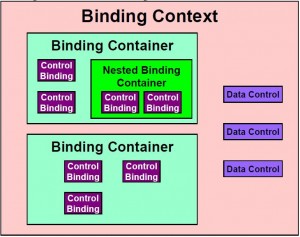Overview
* Based on Oracle ADF Model framework
* Provides an generic API between UI layer and data services layer.
* Provides a standard abstraction for any Java view and controller to bind to any data services.
* Decouples UI layer from data model layer.
* Examples of view and controller:
– JSP
– JSTL
– JSF
– Struts
– Swing
* Examples of service technologies:
– SOAP web services
– EJB session beans
– POJOs that provide access to a model layer
Runtime Architecture
Data Binding Facility (DBF)
* UI <- binding interfaces -> DBF <- data control interfaces -> Data Controls <-> Services <-> Model Object
Roles
* Data Control Provider: creates data controls for a particular service technology (e.g. SOAP WS, EJB SB)
* DBF Provider: provides data binding facility
* Application Developer: uses DBF to access data services
Design Time Architecture
* Relies on metadata
– data control metadata
– binding metadata
Data Controls
* Must implement interface:
javax.bindings.datacontrol.DataControl
Data Control Life Cycle
Instantiating
* All implementations of DataControl interface should provide a no-argument constructor so it can be instantiated via retrospection.
* Metadata key string is passed into DataControl.configure() to
– find metadata by metadata key
– use metadata to acquire an instance of the data control
– prepare itself to receive requests
Cleaning up
* DataControl.release() should be implemented to release all references and resources.
* After release() method call, data control is ready to be garbage collected.
Demarcation of Requests
* Data controls for services that require demarcated requests and sessions should implement interface:
javax.bindings.datacontrol.ManagedDataControl
* Demarcation methods:
# Initialize method: ManagedDataControl.beginRequest(HashMap request); # Cleanup method ManagedDataControl.endRequest(HashMap request); # Reset transaction state ManagedDataControl.resetState();
Retrieving Data
Accessing Attributes of the Service
# Obtain data provider: DataControl.getDataProvider(); # Get access attributes DataControl.getAttributeValue(AttributeContext ctx);
* AttributeContext defines two properties:
– dataProvider
– attributeName
Updating Data
* Data controls that need to update data should implement interface:
javax.bindings.datacontrol.UpdateableDataControl
* Chaining Data values:
setAttributeValue()
* Create/Delete Rows:
# Construct an oracle.bindings.RowContext object RowContext rctx = new RowContext(); # Insert row data UpdateableDataControl.createRowData(RowContext ctx); # Deleting row data UpdateableDataControl.removeRowData(RowContext ctx);
Transaction Control
* Data controls for services that provide transactions should implement interface:
javax.bindings.datacontrol.TransactionalDataControl
* TransactionalDataControl interface defines:
TransactionalDataControl.commitTransaction(); TransactionalDataControl.rollbackTransaction(); TransactionalDataControl.isTransactionDirty();
Invoking Operations
DataControl.invokeOperation(RowContext ctx, OperationBinding binding);
Notifying the DBF of Data Changes
* Data controls that need to broadcast events when data changes should implement the interface:
javax.binding.events.DataChangeManager
* Register/unregister listener:
# Construct a listening class and implement: javax.binding.events.DataChangeListener lisnr = new DataChangeListener(); # Add listener: DataChangeManager.addDataChangeListener(DataObject do, lsnr); # Remove listener: DataChangeManager.removeDataChangeListener(DataObject do);
Structure of Events
* Data change events are instances of the class
javax.binding.events.DataChangeEvent
Metadata and Tooling
Bindings
Binding Context
* Is an instance of java.util.Map
* Allows lookup of all bindings and data controls needed by a module
* Its life cycle is controlled by DBF
* Contains binding containers
– binding container for the current page should be accessible by the String key “bindings”
Binding Container
* Implements javax.bindings.BindingContainer interface, which itself extends java.util.Map
* Allows lookup of binding instances used by a single region
* Contains instances of UI control bindings
* Can be nested
Binding Container Life Cycle
BindingContainer.refresh()
BindingContainer.release()
Retrieval of Control Bindings
# Get a java.util.List of all control bindings in the container: BindingContainer.getControlBindings() ; # Get a List of AttributesBinding instances in the container: BindingContainer.getAttributeBindings(); # Get a List of only the OperationBinding instances in the container: BindingContainer.getOperationBindings(); # Get a single control binding. # It takes, as a parameter, a unique string identifier called the binding’s name. # It returns null if no control binding matching the name is found. BindingContainer.getControlBinding(); # A typesafe version of getControlBinding() that returns an OperationBinding instance, # typed to OperationBinding. # It accepts the binding’s name as a parameter, # and returns null if either no binding matching that name is found # or if the binding matching the name is not an instance of OperationBinding. BindingContainer.getOperationBinding();
Token Validation
* Could be used to prevent multiple submit actions
# Returns true if token validation is enabled, false otherwise: BindingContainer.isTokenValidationEnabled(); # Obtain state token: BindingContainer.getStateToken(); # Should throw an exception if token is invalid: BindingContainer.validateToken()
Data Validation
* Binding container implementations should also implement the method BindingContainer.validate().
* This method is a delegate method, which should call DataControl.validate() on every data control referenced by the container.
Control Bindings
* All control bindings mus implement interface
javax.bindings.ControlBinding
* Control bindings provide data access for individual UI controls
* Control bindings include bindings to
– individual attribute values
– entire model objects with multiple attributes
– collections that maintain entire ranges of model objects
– execute operation son the model layer
Identify and Resolve Control Bindings
* Each control binding must have a unique string within its binding container
# Obtain control binding name: ControlBinding.getName(); # Obtain complete dot delimited path: ControlBinding.getPath(); # Obtain all aspects of data controls: ControlBinding.getProviderFullName()
Releasing Control Bindings
* Release a control bindings: ControlBinding.release()
Attribute Bindings
* All attribute bindings should implement interface
javax.bindings.AttributeBinding
* Attribute bindings provide both read and write access to a single attribute
# read: AttributeBinding.getInputValue(); # write: AttributeBinding.setInputValue(); # read only access: AttributeBinding.isReadOnly(); # Attribute can have labels AttributeBinding.getLabel();
Attributes Bindings
* Must implement
javax.bindings.AttributesBinding
* Provide index-based access (both read and write ) to multiple attribute values
# read: AttributesBinding.getInputValue(); # write: AttributesBinding.setInputValue(int idx, myVal); # is updateable: AttributesBinding.isUpdateable(); # Get an array of labels: AttributesBinding.getLabelSet();
Range Bindings
* Must implement
javax.bindings.RangeBinding
* Provide read only access to attribute values over a collection
RangeBinding.getRangeSet();
Operation Bindings
* Must implement
javax.bindings.OperationBinding
* Methods defined in OperationBinding interface:
OperationBinding.isOperationEnabled(); OperationBinding.getParamsMap(); OperationBinding.execute(); # Should delegate to DataControl.invokeOperation() OperationBinding.getResult(); OperationBinding.getErrors();
* Provide access to operations supported by the data control
# Get OperationInfo object from binding OperationInfo opinfo = OperationBinding.getOperationInfo(); # Use OperationInfo object to obtain various operation info: opinfo.getInstanceName(); opinfo.getOperationName(); opinfo.getReturnName();

